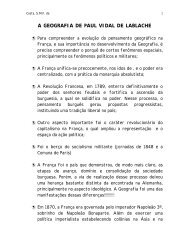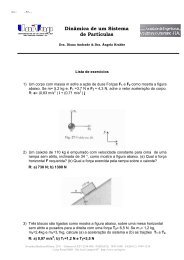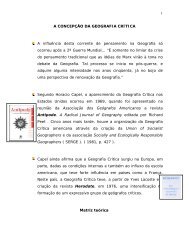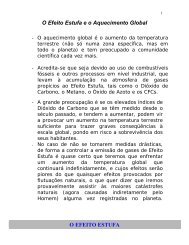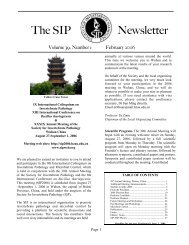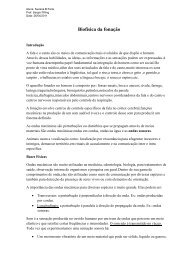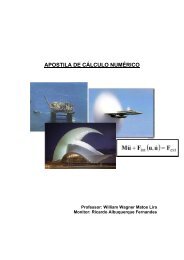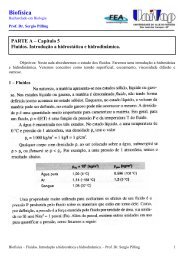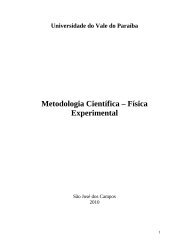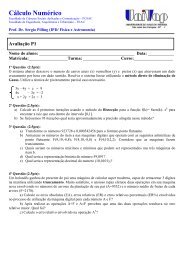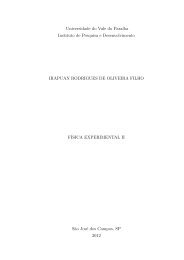F0007 - Phylum Zygomycota and the new classification - Univap
F0007 - Phylum Zygomycota and the new classification - Univap
F0007 - Phylum Zygomycota and the new classification - Univap
You also want an ePaper? Increase the reach of your titles
YUMPU automatically turns print PDFs into web optimized ePapers that Google loves.
Clinical Microbiology Reviews, April 2000, p. 236-301, Vol. 13, No. 2Zygomycetes in Human DiseaseJulie A. Ribes, Carolyn L. Vanover-Sams, <strong>and</strong> Doris J. BakerSchematic diagram labeling <strong>the</strong> morphologic structures seen in<strong>the</strong> sporangium-producing Mucorales (A) Rhizopus spp. (B)Apophysomyces elegans.<strong>Zygomycota</strong> DENR 25Gross morphology of Rhizopus, Mucor, <strong>and</strong> Absidiaisolates in culture. (A) Rhizopus gross morphology onSABHI medium. Rhizopus spp. typically produce avery high, fibrous colony that rapidly fills <strong>the</strong> entirepetri dish. This isolate has exp<strong>and</strong>ed to <strong>the</strong> lid(known as a "lid lifter"). It has produced abundantpigmented sporangia, which are seen as <strong>the</strong> dark areaspeppering <strong>the</strong> o<strong>the</strong>rwise pale mycelium. Thismorphology is characteristic of <strong>the</strong> Rhizopus spp. (B)Low-growing Mucor variant gross morphology onSABHI medium. Mucor spp. will show variation fromculture to culture. This particular isolate has produceda low-growing, fibrous colony morphology thatreadily demonstrates <strong>the</strong> "woolly" or floccose growthcharacteristic of <strong>the</strong> Mucoraceae. Pigmentation is alsovariable, both within <strong>and</strong> among <strong>the</strong> Mucor spp.Increased pigmentation is generally reflective of areasof <strong>the</strong> mycelium that are rich in sporangia. Dependingon <strong>the</strong> individual isolate, Mucor may be extremelyfloccose or low growing <strong>and</strong> may range from purewhite to shades of gray or brown. (C) Absidiacorymbifera gross colony morphology on SABHImedium. A. corymbifera produces a light-coloredmycelium, generally cream or gray. The pepperedappearance seen in <strong>the</strong> Rhizopus spp. is lacking despite<strong>the</strong> production of abundant sporangia. The myceliumof this isolate is firmly plastered to <strong>the</strong> lid of <strong>the</strong> petridish, consistent with <strong>the</strong> lid-lifting properly of thisfungus. (D) A. corymbifera, reverse side of <strong>the</strong> cultureplate shown in panel C. The Mucoraceae are hyalinemolds that produce a pale reverse in culture onst<strong>and</strong>ard media such as SABHI agar. Although someisolates such as Rhizopus spp. may have lightlypigmented hyphal elements, this is generally reflectedas a pale yellow or brown reverse <strong>and</strong> not <strong>the</strong> darklyClinical Microbiology Reviews, April 2000, p. 236-301, Vol. 13, No. 2 pigmented reverse of <strong>the</strong> dematiaceous fungi.Zygomycetes in Human Disease<strong>Zygomycota</strong> DENR 26Julie A. Ribes, Carolyn L. Vanover-Sams, <strong>and</strong> Doris J. BakerGross morphology of Basidiobolus, Conidiobolus,<strong>and</strong> Mucor colonies in culture. (A) Basidiobolusmicrosporus colony morphology on SABHI agar.Dense, waxy, folded, or furrowed colonies areproduced on st<strong>and</strong>ard culture media. Coloniesare low growing, lacking <strong>the</strong> floccosemorphology seen in <strong>the</strong> typical isolate of <strong>the</strong>Mucorales (see Mucor morphology in panel B).This isolate produced a brownish orange colonythat was pale on reverse. (B) Mucor colonymorphology on SABHI agar. The floccose or"woolly" colony morphology produced by mostof <strong>the</strong> Mucorales is well demonstrated in thisMucor isolate. Contrast <strong>the</strong> fibrous aerialmycelium with <strong>the</strong> glabrous morphology seenfor both Basidiobolus (A) <strong>and</strong> Conidiobolus (C).Basidiobolus microsporusThis difference in colony morphology is one of<strong>the</strong> distinguishing features between <strong>the</strong> Mucorales<strong>and</strong> <strong>the</strong> Entomophthorales. (C) Conidioboluscoronatus colony morphology on Sabourauddextrose agar slant. Similar to Basidiobolus spp.,Conidiobolus spp. produce low-growing waxy (orsometimes powdery) folded <strong>and</strong> furrowedcolonies that lack aerial mycelium. Satellitecolonies arising from germination of ejectedsporangiospores has lead to confluent growth inthis tube containing a 6-week-old culture. (D)Conidiobolus coronatus tube culture, side view of<strong>the</strong> tube in panel C. Note <strong>the</strong> cloudy appearanceof <strong>the</strong> glass surface of <strong>the</strong> tube. This isproduced by <strong>the</strong> collection of a plethora offorcibly expelled sporangiospores which haveClinical Microbiology Reviews, April 2000, p. 236-301, Vol. 13, No. 2become encrusted on <strong>the</strong> inside surface of <strong>the</strong>tube. This opacification of <strong>the</strong> culture tube (orZygomycetes in Human Disease <strong>Zygomycota</strong> DENRpetri dish lid) is characteristic of this organism.27Julie A. Ribes, Carolyn L. Vanover-Sams, <strong>and</strong> Doris J. BakerZygomycetes• O processo da reproduçãosexual consiste da fusão de doisgametângios d<strong>and</strong>o a origem aum zigosporo (esporo de repousocom parede espessa) dentro de umzigosporângio<strong>Zygomycota</strong> DENR 28Compatibilidade Sexual• Regulamentado pela ácido trispórico, umferomônio sexual (Blakeslee, 1904):– Aumenta a secreção de determinados precursoresde ácido trispórico e beta-caroteno– Positivamente regulamenta a sua própria síntese,estimul<strong>and</strong>o a taxa precursores da formação emculturas pareadas– Induz a formação zigosporangio– Reprime formação do esporangióforo<strong>Zygomycota</strong> DENR 29Zygomycetes• Homotálico – requer apenas um talo(hifa) para reprodução sexual• Heterotálico – requer dois talos (hifas) desexos opostos para reprodução sexual,designadas mais (+) ou menos (-)– Sexual spore produced by conjugation when(+) hyphae e (-) fuse is calledzygosporangium<strong>Zygomycota</strong> DENR 305



